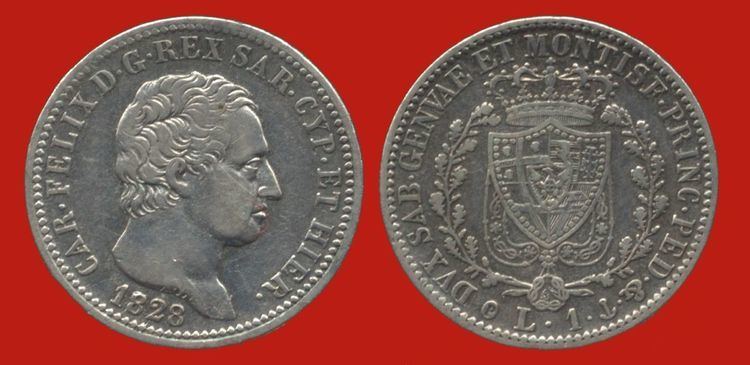Symbol ₤ | ||
 | ||
Coins c.1, c.3, c.5c.25, c.50, ₤1, ₤2, ₤5 Rarely used ₤10, ₤20, ₤40, ₤50, ₤80, ₤100 | ||
The lira (plural lire) was the currency of the Kingdom of Sardinia between August 6, 1816 and March 17, 1861. It was subdivided into 100 centesimi (singular centesimo) and was equal in value to the French franc (4.5 grams of silver), which had replaced the Piedmontese shield by 1801. Being no more than the Savoyard version of the franc, it could circulate also in France, as the French coins could circulate in Piedmont. It was replaced at par by the Italian lira. As the great part of the 19th century currencies, it was not affected by significant episodes of inflation during all its existence.
Coins
In 1816, King Victor Emmanuel I issued silver 5 lire and gold 20 lire coins. Before his abdication in 1821, he also produced a new golden 80 lire coin.
King Charles Felix followed in 1821 and 1822 minting gold 40 and 80 lire, respectively. He also expanded the new currency in Sardinia which, not having been conquered by Napoleon, had retained its Sardinian shields. Silver 50 centesimi, 1 and 2 lire were added in 1823, followed by copper 1, 3 and 5 centesimi in 1826, and silver 25 centesimi in 1829.
Finally, King Charles Albert added new gold 10, 50 and 100 lire in 1832, while King Victor Emmanuel II continued his father's coinage.
On each coin, the ruling monarch was styled in Latin as King of Sardinia, Cyprus and Jerusalem by the Grace of God on the front side, and Duke of Savoy, Genoa and Montferrat, Prince of Piedmont et cetera on the back side.
